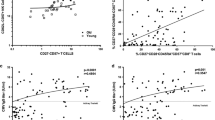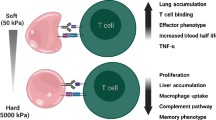Summary
Production of effective vaccine formulations is dependent on the availability of assays for the measurement of protective immune responses. The development and standardization of in vitro human cell-based assays for functional opsonophagocytic antibodies require critical evaluation and optimization of the preparation of cells for the assay. We report evaluation of a number of protocols with two continuous cell lines (NB-4 and HL-60) for the provision of differentiated cells for use in functional assays. Flow cytometric analysis of CD11b antigen expression, as a marker of differentiation, indicated that all-trans-retinoic acid (ATRA) gave improved differentiation (>80% of cells differentiated at 96 h) when compared with dimethylformamide (DMF) (<60% of cells differentiated at 96 h). Morphological changes during differentiation toward a neutrophil-like phenotype were assessed by scanning electron microscopy. HL-60 and NB-4 cells treated with ATRA showed more spreading and flattening than cells treated with DMF, further evidence that they may have achieved a more differentiated phenotype. The number of cell divisions in culture appeared to be critical because cell lines maintained in exponential growth for >40 passages failed to express CD11b antigen or show morphological changes associated with differentiation after exposure to either differentiation-inducing reagent. Late-passage cells also demonstrated increased tolerance to DMF. Our results indicated that ATRA supplemented with vitamin D3 and granulocyte colony-stimulating factor affords robust, rapid, and reproducible differentiation of both cell types.
Similar content being viewed by others
References
Bailly, A.; Le Page, C.; Rauch, M.; Milgrom, E. Sequence-specific DNA binding of the progesterone receptor to the uteroglobin gene: effects of hormone, anti-hormone and receptor phosphorylation. EMBO J. 5:3235–3241; 1986.
Battle, T. E.; Levine, R. A.; Yen, A. Retinoic acid-induced blr1 expression promotes ERK2 activation and cell differentiation in HL60 cells. Exp. Cell Res. 254:287–298; 2000.
Bunce, C. M.; French, P. J.; Durham, J.; stockley, R. A.; Michell, R. H.; Brown, G. Indomethacin potentiates the induction of HL60 differentiation to neutrophils, by retinoic acid and granulocyte colony-stimulating factor, and to monocytes, by Vitamin D3. Leukemia 8:595–604; 1994.
Bunce, C. M.; Wallington, L. A.; Harrison, P.; Williams, G. R.; Brown, G. Treatment of HL60 with various combinations of retinoids and 1α,25 dihydroxyvitamin D3 results in differentiation towards neutrophils or monocytes or a failure to differentiate and apoptosis. Leukemia 9:410–418; 1995.
Collins, S. J.; Gallo, R. C.; Gallagher, R. E. Continuous growth and differentiation of human myeloid leukaemic cells in suspension culture. Nature 270:347–349; 1977.
Coughlin, R.; White, A.; Anderson, C.; Carlone, G.; Klein, D.; Treanor, J. Characterization of pneumococcal specific antibodies in healthy unvaccinated adults. Vaccine 16:1761–1767; 1998.
Esposito, A. I.; Clark, C. A.; Poirier, W. J. An assessment of the factors contributing to the killing of type 3 Streptococcus pneumoniae by human polymorphonuclear leukocytes in vitro. APMIS 98:111–121; 1990.
Fleck, R. A.; Athwal, H.; Hockley, D. J. Optimisation of cell substrates for a functional opsonophagocytotic assay; a scanning electron microscopy study. G.I.T. Imaging Microsc. 4:4–7; 2002.
Gallagher, R.; Collins, S.; Trujillo, J., et al. Characterization of the continuous, differentiating myeloid cell line (HL-60) from a patient with acute promyelocytic leukaemia. Blood 54:713–733; 1979.
Goldberg, Y.; Glineur, C.; Gesquière, J.-C.; Ricouart, A.; Sap, J.; Vennström, B.; Ghysdael, J. Activation of protein kinase C or camp-dependent protein kinase increases phosphorylation of the c-erbA-encoded thyroid hormone receptor and of the v-erbA-encoded protein. EMBO J. 7:2425–2433; 1988.
Henderson, B.; Wilson, M.; McNab, R.; Lax, A. J. The innate immune response. In: Henderson, B.; Wilson, M.; McNab, R.; Lax, A. J., ed. Cellular microbiology, bacteria-host interactions in health and disease. Chichester: John Wiley & Son; 1999:311–353.
Hockley, D. J.; Jackson, M. H. The baigent apparatus for continuous-flow processing of SEM specimens. Proc. RMS 35:187–194; 2000.
Hockley, D. J.; Jackson, M. H.; Fleck, R. A. Using the baigent apparatus for continuous-flow processing of SEM specimens. Proc. RMS 32:110–115; 2001.
Lanotte, M.; Martinthouvenin, V. NB4, a maturation inducible cell-line with T(15–17) marker isolated from a human acute promyelocytic leukemia (M3). Blood 77:1080–1086; 1991.
Liebermann, D. A.; Hoffman-Liebermann, B. Genetic programs of myeloid cell differentiation. Curr. Opin. Hematol. 1:24–32; 1994.
Lin, K.; Ashizawa, K.; Cheng, S. Phosphorylation stimulates the transcriptional activity of the human β1 thyroid hormone nuclear receptor. Proc. Natl. Acad. Sci. 89:7737–7741; 1992.
Lu, L.; Broxmeyer, H. E.; Pelus, L. M.; Andreeff, M.; Moore, M. A. S. Detection of Luxol-fast-blue positive cells in human promyelocytic leukaemia cell line HL-60. Exp. Hematol. 9:887–892; 1981.
Martinez, J. E.; Romero-Steiner, S.; Pilishvili, T.; Barnard, S.; Schinsky, J.; Goldblatt, D.; Carlone, G. M. A flow cytometric opsonophagocytic assay for measurement of functional antibodies elicited after vaccination with the 23-valent pneumococcal polysaccharide vaccine. Clin. Diagn. Lab. Immunol. 6:581–586; 1999
Musher, D.; Chapman, A. J.; Goree, A.; Jonsson, S.; Briles, D. E.; Baughn, R. E. Natural and vaccine related immunity to Streptococcus pneumoniae: prevalence, persistence, and response to re-vaccination. J. Infect. Dis. 154:245–256; 1986.
Patrick, S.; Larkin, M. J. Clearance mechanisms: complement, phagocytosis and cell mediated cytotoxicity. In: Patrick, S.; Larkin, M. J., ed. Immunological and molecular aspects of bacterial virulence. Chichester: John Wiley & Son; 1995:47–67.
Quataert, S. A.; Kirch, C. S.; Wiedl, L. J. Q.; Phipps, D. C.; Strohmeyer, S.; Cimino, C. O.; Skuse, J.; Madore, D. V. Assignment of weight-based antibody units to a human antipneumococcal standard reference serum, lot 89-S. Clin. Diagn. Lab. Immunol. 2:590–597; 1995.
Romero-Steiner, S.; Libutti, D.; Pais, L. B.; Dykes, J.; Anderson, P.; Whitin, J. C.; Keyserling, H. L.; Carlone, G. M. Standardization of an opsonophagocytic assay for the measurement of functional antibody activity against Streptococcus pneumoniae using differentiated HL-60 cells. Clin. Diagn. Lab. Immunol. 4:415–422; 1997.
Sveum, R. J.; Chused, T. M.; Frank, M. M.; Brown, E. J. A quantitative fluorescent method for measurement of bacterial adherence and phagocytosis. J. Immunol. Methods 90:257–264; 1986.
Touhami, M.; Bourge, J.-F.; Legrand, C. Increased adhesion of the promyelocytic leukaemia cell line, NB4, to fibronectin and thrombospondin upon all-trans-retinoic acid treatment. Br. J. Haematol. 104:706–714; 1999.
Author information
Authors and Affiliations
Corresponding author
Rights and permissions
About this article
Cite this article
Fleck, R.A., Athwal, H., Bygraves, J.A. et al. Optimization of NB-4 and HL-60 differentiation for use in opsonophagocytosis assays. In Vitro Cell.Dev.Biol.-Animal 39, 235–242 (2003). https://doi.org/10.1290/1543-706X(2003)039<0235:OONAHD>2.0.CO;2
Received:
Accepted:
Issue Date:
DOI: https://doi.org/10.1290/1543-706X(2003)039<0235:OONAHD>2.0.CO;2




